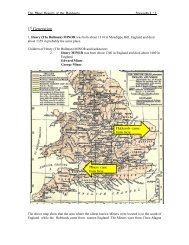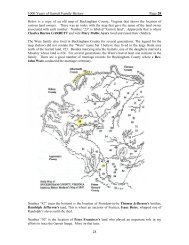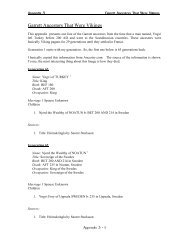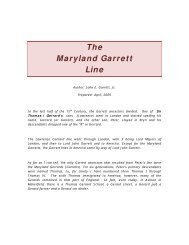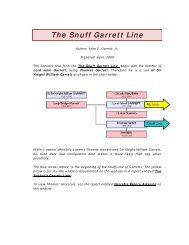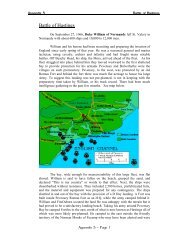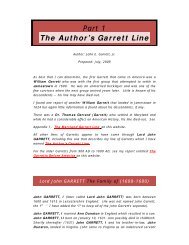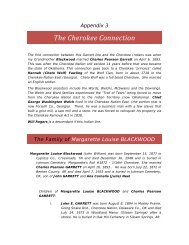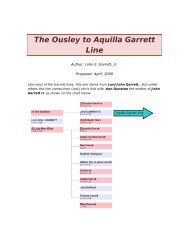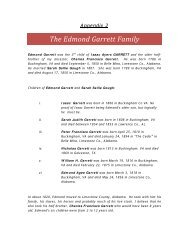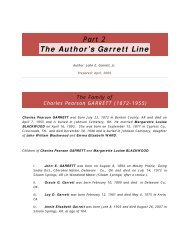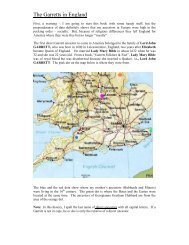The Bates-Fleming Line (1286-1900) - Garrett Family Genealogy
The Bates-Fleming Line (1286-1900) - Garrett Family Genealogy
The Bates-Fleming Line (1286-1900) - Garrett Family Genealogy
You also want an ePaper? Increase the reach of your titles
YUMPU automatically turns print PDFs into web optimized ePapers that Google loves.
<strong>The</strong> <strong>Bates</strong>-<strong>Fleming</strong> <strong>Line</strong> (<strong>1286</strong>-<strong>1900</strong>)<br />
44. Gov. Frederick <strong>Bates</strong> was born June 23, 1777 and died August 4, 1825. He married<br />
Nancy Opie BATES March 4, 1819. She was born April 19, 1802 in Lancaster Co., VA and<br />
died March 16, 1877 in Thronhill Estate.<br />
Children of Gov. Frederick <strong>Bates</strong> and Nancy Opie BATES:<br />
i. 54. Dr. Fredrick <strong>Bates</strong> was born February 1, 1826 in born after death of<br />
father and died October 18, 1862.<br />
ii. Emily C. <strong>Bates</strong> was born January 5, 1820.<br />
iii. 55. Lucas (Lucius) Lee <strong>Bates</strong> was born March 18, 1821 and died<br />
October 24, 1898.<br />
iv. 56. Woodville <strong>Bates</strong> was born February 10, 1823 and died February 12,<br />
1840.<br />
On the left –<br />
<strong>The</strong> Thornhill farm includes the home and utility<br />
buildings of Frederick <strong>Bates</strong>, his wife Nancy and<br />
their children, and shows how this family lived<br />
on the frontier in the early 1800s. But Frederick<br />
<strong>Bates</strong> was more than just a farmer; he played a<br />
pivotal role in bringing the Louisiana Territory<br />
under the control of the United States<br />
government. <strong>The</strong> site includes his 1820s home,<br />
barn, reconstructed summer kitchen, ice and<br />
smoke house, orchard and herb garden, and<br />
family cemetery. <strong>The</strong> home has been restored and partially furnished to look as it did when<br />
Governor <strong>Bates</strong> would set off on a one to two-day trek to St. Charles, Missouri, then the<br />
first capital of the state.<br />
Frederick <strong>Bates</strong>' contributions to this growing area began when he came to St. Louis in<br />
1807, just one year after the return of Lewis and Clark's "Tour of Discovery" opened the<br />
west. He began as the Secretary, Recorder of Land Titles and a member of the Board of<br />
Land Commissioners in the new territory. In these posts he helped determine whether<br />
Spanish, French or American claims and customs would predominate. As Secretary, he<br />
served as acting Territorial Governor for much of the time. He was also responsible for<br />
codification of territorial laws and compiled the first book published in Missouri. On<br />
November 17, 1824, in St. Charles, <strong>Bates</strong> was sworn in as second governor of Missouri,<br />
succeeding Alexander NcNair. On August 4 the following year, however, he died of pleurisy.<br />
He is buried in the family cemetery near his house with his wife and two of his children.<br />
Page 20



